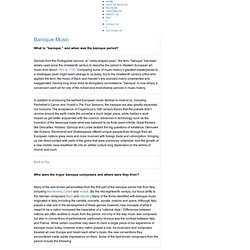

Handel, G.F. (1685-1759) - Rinaldo - Lascia ch'io pianga - Magdalena Kožená, Marcon. Handel, Theodora HWV 68 overture. Handel: Theodora - "With Darkness Deep" - Magdalena Kozena. Handel, G.F. (1685-1759) - Joshua - Oh! Had I Jubal's Lyre - Magdalena Kožená, Marcon. Kol' slaven nash Gospod - New Haven Oratorio Choir (NHOC) May 2010. About the “Baroque” Period. Baroque Music What is “baroque,” and when was the baroque period?

Derived from the Portuguese barroco, or “oddly shaped pearl,” the term “baroque” has been widely used since the nineteenth century to describe the period in Western European art music from about 1600 to 1750. Comparing some of music history’s greatest masterpieces to a misshapen pearl might seem strange to us today, but to the nineteenth century critics who applied the term, the music of Bach and Handel’s era sounded overly ornamented and exaggerated. Having long since shed its derogatory connotations, “baroque” is now simply a convenient catch-all for one of the richest and most diverse periods in music history. In addition to producing the earliest European music familiar to most of us, including Pachelbel’s Canon and Vivaldi’s The Four Seasons, the baroque era also greatly expanded our horizons.
Back to Top Who were the major baroque composers and where were they from? France: Couperin, Lully, Charpentier and Rameau. Baroque sacred music - oratorio. Baroque era is known for its several grand forms of church music, including the passion, the oratorio, or the cantata.

They were all based on texts refering to the sacred religious book (Bible), although the setting was different between these three music forms. The passion was based on Jesus' suffering and was based on the Gospel texts, the Oratorio was more poetic and could be about any other Biblical story, while cantatas were based on Biblical texts. It is quite remarkable that in the midst of separation between the sacred and the secular, composers wrote for both of the worlds. They didn't necessarily fought on either side of the schism. And that's understandable since they wanted to get famous, or saw it as a way to get jobs or get paid by different employers (even the Protestant J.S. A standard device that was used to accompany the singers in the church music, but that was borrowed from the opera, was basso continuo. Oratorio. History[edit] 1600, origins of the oratorio[edit] Although medieval plays such as the Ludus Danielis, and Renaissance dialogue motets such as those of the Oltremontani had characteristics of an oratorio, the first oratorio is usually seen as Emilio de Cavalieri's Rappresentatione di Anima, et di Corpo.

Monteverdi composed Il Combattimento di Tancredi e Clorinda which can be considered as the first secular oratorio. 1650–1700[edit] By the mid-17th century, two types had developed: Lasting about 30–60 minutes, oratorio volgares were performed in two sections, separated by a sermon; their music resembles that of contemporary operas and chamber cantatas. oratorio latino (in Latin) – first developed at the Oratorio del Santissimo Crocifisso, related to the church of San Marcello al Corso in Rome. The late baroque oratorio[edit] In the late baroque oratorios increasingly became "sacred opera". The oratorio in Georgian Britain[edit]